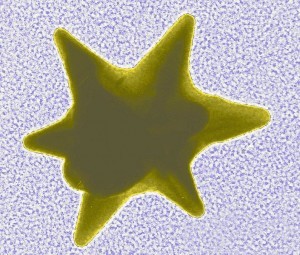Technion-Israel Institute of Technology research shows for first time inhaled
nanoparticles of silicon dioxide increase risk of atherosclerosis;
laboratory, manufacturing workers may be at greatest risk. Nanoparticles, extremely tiny
particles measured in billionths of a meter, are increasingly
everywhere, and especially in biomedical products. Their toxicity has
been researched in general terms, but now a team of Israeli scientists
has for the first time found that exposure nanoparticles (NPs) of
silicon dioxide (SiO2) can play a major role in the development of
cardiovascular diseases when the NP cross tissue and cellular barriers
and also find their way into the circulatory system.Their study,
published in the December issue of Environmental Toxicology, can be found on-line at http://onlinelibrary.wiley.
The research team was comprised
of scientists from the Technion Rappaport Faculty of Medicine, Rambam
Medical Center, and the Center of Excellence in Exposure Science and
Environmental Health (TCEEH).
 “Environmental exposure to
nanoparticles is becoming unavoidable due to the rapid expansion of
nanotechnology,” says the study’s lead author, Prof. Michael Aviram, of
the Technion Faculty of Medicine, “This exposure may be especially
chronic for those employed in research laboratories and in high tech
industry where workers handle, manufacture, use and dispose of
nanoparticles. Products that use silica-based nanoparticles for
biomedical uses, such as various chips, drug or gene delivery and
tracking, imaging, ultrasound therapy, and diagnostics, may also pose an
increased cardiovascular risk for consumers as well.”
“Environmental exposure to
nanoparticles is becoming unavoidable due to the rapid expansion of
nanotechnology,” says the study’s lead author, Prof. Michael Aviram, of
the Technion Faculty of Medicine, “This exposure may be especially
chronic for those employed in research laboratories and in high tech
industry where workers handle, manufacture, use and dispose of
nanoparticles. Products that use silica-based nanoparticles for
biomedical uses, such as various chips, drug or gene delivery and
tracking, imaging, ultrasound therapy, and diagnostics, may also pose an
increased cardiovascular risk for consumers as well.”
In this study, researchers
exposed cultured laboratory mouse cells resembling the arterial wall
cells to NPs of silicon dioxide and investigated the effects. SiO2 NPs
are toxic to and have significant adverse effects on macrophages. a type
of white blood cell that take up lipids, leading to atherosclerotic
lesion development and its consequent cardiovascular events, such as
heart attack or stroke. Macrophages accumulation in the arterial wall
under atherogenic conditions such as high cholesterol, triglycerides,
oxidative stress – are converted into lipids, or laden “foam cells”
which, in turn, accelerate atherosclerosis development.
“Macrophage foam cells
accumulation in the arterial wall are a key cell type in the development
of atherosclerosis, which is an inflammatory disease” says co-author
Dr. Lauren Petrick. “The aims of our study were to gain additional
insight into the cardiovascular risk associated with silicon dioxide
nanoparticle exposure and discover the mechanisms behind Si02’s induced
atherogenic effects on macrophages. We also wanted to use nanoparticles
as a model for ultrafine particle (UFP) exposure as cardiovascular
disease risk factors.”
Both NPs and UFPs can be inhaled
and induce negative biological effects. However, until this study, their
effect on the development of atherosclerosis has been largely unknown.
Here, researchers have discovered for the first time that the toxicity
of silicon dioxide nanoparticles has a “significant and substantial
effect on the accumulation of triglycerides in the macrophages,” at all
exposure concentrations analyzed, and that they also “increase oxidative
stress and toxicity.”
A recent update from the American Heart Association also
suggested that “fine particles” in air pollution leads to elevated risk
for cardiovascular diseases. However, more research was needed to
examine the role of “ultrafine particles” (which are much smaller than
“fine particles”) on atherosclerosis development and cardiovascular
risk.
“The number of nano-based
consumer products has risen a thousand fold in recent years, with an
estimated world market of $3 trillion by the year 2020,” conclude the
researchers. “This reality leads to increased human exposure and
interaction of silica-based nanoparticles with biological systems.
Because our research demonstrates a clear cardiovascular health risk
associated with this trend, steps need to be taken to help ensure that
potential health and environmental hazards are being addressed at the
same time as the nanotechnology is being developed.